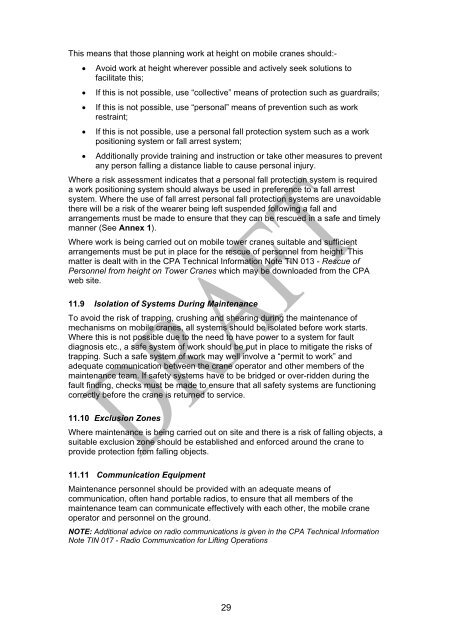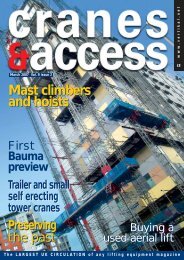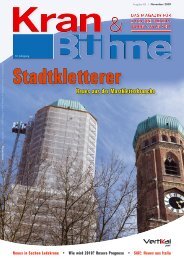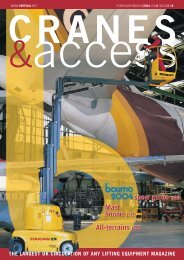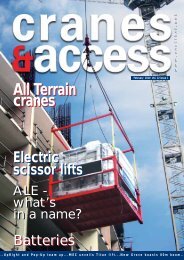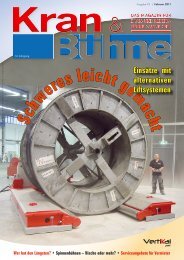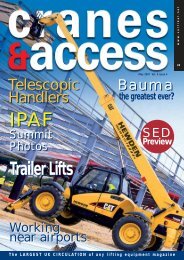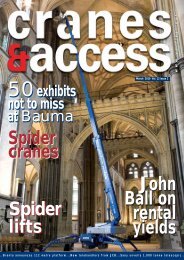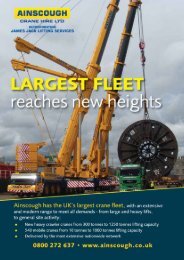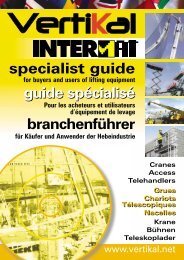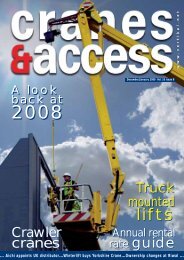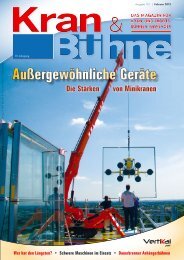Maintenance, Inspection and Thorough Examination of Mobile Cranes
Maintenance, Inspection and Thorough Examination of Mobile Cranes
Maintenance, Inspection and Thorough Examination of Mobile Cranes
Create successful ePaper yourself
Turn your PDF publications into a flip-book with our unique Google optimized e-Paper software.
This means that those planning work at height on mobile cranes should:-<br />
� Avoid work at height wherever possible <strong>and</strong> actively seek solutions to<br />
facilitate this;<br />
� If this is not possible, use “collective” means <strong>of</strong> protection such as guardrails;<br />
� If this is not possible, use “personal” means <strong>of</strong> prevention such as work<br />
restraint;<br />
� If this is not possible, use a personal fall protection system such as a work<br />
positioning system or fall arrest system;<br />
� Additionally provide training <strong>and</strong> instruction or take other measures to prevent<br />
any person falling a distance liable to cause personal injury.<br />
Where a risk assessment indicates that a personal fall protection system is required<br />
a work positioning system should always be used in preference to a fall arrest<br />
system. Where the use <strong>of</strong> fall arrest personal fall protection systems are unavoidable<br />
there will be a risk <strong>of</strong> the wearer being left suspended following a fall <strong>and</strong><br />
arrangements must be made to ensure that they can be rescued in a safe <strong>and</strong> timely<br />
manner (See Annex 1).<br />
Where work is being carried out on mobile tower cranes suitable <strong>and</strong> sufficient<br />
arrangements must be put in place for the rescue <strong>of</strong> personnel from height. This<br />
matter is dealt with in the CPA Technical Information Note TIN 013 - Rescue <strong>of</strong><br />
Personnel from height on Tower <strong>Cranes</strong> which may be downloaded from the CPA<br />
web site.<br />
11.9 Isolation <strong>of</strong> Systems During <strong>Maintenance</strong><br />
To avoid the risk <strong>of</strong> trapping, crushing <strong>and</strong> shearing during the maintenance <strong>of</strong><br />
mechanisms on mobile cranes, all systems should be isolated before work starts.<br />
Where this is not possible due to the need to have power to a system for fault<br />
diagnosis etc., a safe system <strong>of</strong> work should be put in place to mitigate the risks <strong>of</strong><br />
trapping. Such a safe system <strong>of</strong> work may well involve a “permit to work” <strong>and</strong><br />
adequate communication between the crane operator <strong>and</strong> other members <strong>of</strong> the<br />
maintenance team. If safety systems have to be bridged or over-ridden during the<br />
fault finding, checks must be made to ensure that all safety systems are functioning<br />
correctly before the crane is returned to service.<br />
11.10 Exclusion Zones<br />
Where maintenance is being carried out on site <strong>and</strong> there is a risk <strong>of</strong> falling objects, a<br />
suitable exclusion zone should be established <strong>and</strong> enforced around the crane to<br />
provide protection from falling objects.<br />
11.11 Communication Equipment<br />
<strong>Maintenance</strong> personnel should be provided with an adequate means <strong>of</strong><br />
communication, <strong>of</strong>ten h<strong>and</strong> portable radios, to ensure that all members <strong>of</strong> the<br />
maintenance team can communicate effectively with each other, the mobile crane<br />
operator <strong>and</strong> personnel on the ground.<br />
NOTE: Additional advice on radio communications is given in the CPA Technical Information<br />
Note TIN 017 - Radio Communication for Lifting Operations<br />
29


